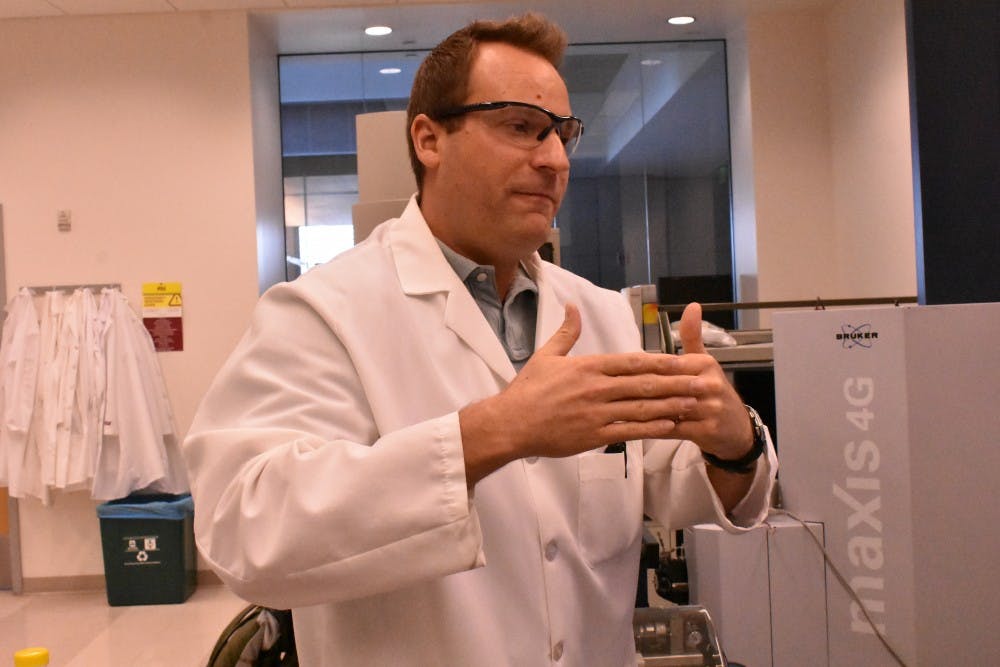ASU's Biodesign Institute is on the cutting edge of bio-science. It houses the research of professors like Chad Borges and Tony Hu, which has the potential to save millions of lives.
“The scientists here not only come from all over the world but all sorts of disciplines,” Joe Caspermeyer, Biodesign Institute’s communications representative, said. “We have about 100 research scientists working here, about 500 personnel and 13 research centers working to solve everything from big problems (like cancer) to the latest outbreaks like Zika.”
One of the 13 centers is the Biodesign Virginia G. Piper Center for Personalized Diagnostics. The center’s goal is to decrease mortality rates by developing more personalized and effective treatments for diseases like cancer.
Borges, an assistant professor at the Biodesign Virginia G. Piper Center for Personalized Diagnostics, conducts research using biomarkers, specifically glycans, to detect cancer earlier than the current standard tests.
“A biomarker is a molecular indicator of disease. They can sometimes be used alone or in combinations to diagnose a disease,” Borges said. “What we’re doing is subdividing a disease that you might call lung cancer or breast cancer into very specific subtypes of those kinds of cancer.”
He said scientists like him and his team are starting to collect samples from several patients to create more specific definitions of cancer in order to improve therapy.
“It’s more personalized than just going with the old hack and slash chemotherapy surgery," Borges said. "(Doctors) can use detailed molecular information that puts patients in a particular subclass of cancer and give them the best possible treatment.”
Borges said the biomarkers being developed by him and his team have proven to be more effective at tracking the progression of cancer, rather than detecting it early on.
He also said recent development in their research shows that looking at glycans has the potential to predict recurrence.
Hu, also an associate professor at the Biodesign Virginia G. Piper Center for Personalized Diagnostics, focuses on the development of nanotechnology to expedite the diagnosis of diseases. His research in nanotechnology also has the potential to reduce the cost of screening for tuberculosis, cancer, HIV and Ebola.
“It’s difficult to diagnose cancers like pancreatic cancer and ovarian cancer in the early stages," Hu said. "Most pancreatic cancer patients die within a year of being diagnosed.”
He and his team are developing nanoparticles to help identify tumor cells in the blood. Not only would this technology detect cancer earlier than current methods, but it would also reduce the time it takes to get results from 24 hours to one hour.
“We don't have too many cases of TB in countries like the United States," Hu said. "However, we do spend a lot of money in screening for TB. I don’t know how much the industry will charge for the test in the future, but for us, the test costs $5. Right now people are using the T-SPOT test which costs over $120.”
Hu also said the development of more efficient tests for TB are important because millions of people are diagnosed with the disease in developing countries.
In addition to lab work, the scientists at the Biodesign Institute collaborate with the larger research community to test their hypotheses and advance their research.
Hu and his team collaborate with the U.S. Army to help treat TB and Ebola patients in developing countries. Borges and his team collaborate with local clinics to access samples.
The goal of personalized diagnostics is to develop a more efficient process of diagnosing disease. Researchers like Borges and Hu are making substantial headway in this specialized field.
Reach the reporter at cazares429@gmail.com or follow @sonic_429 on Twitter.
Like State Press on Facebook and follow @statepress on Twitter.




